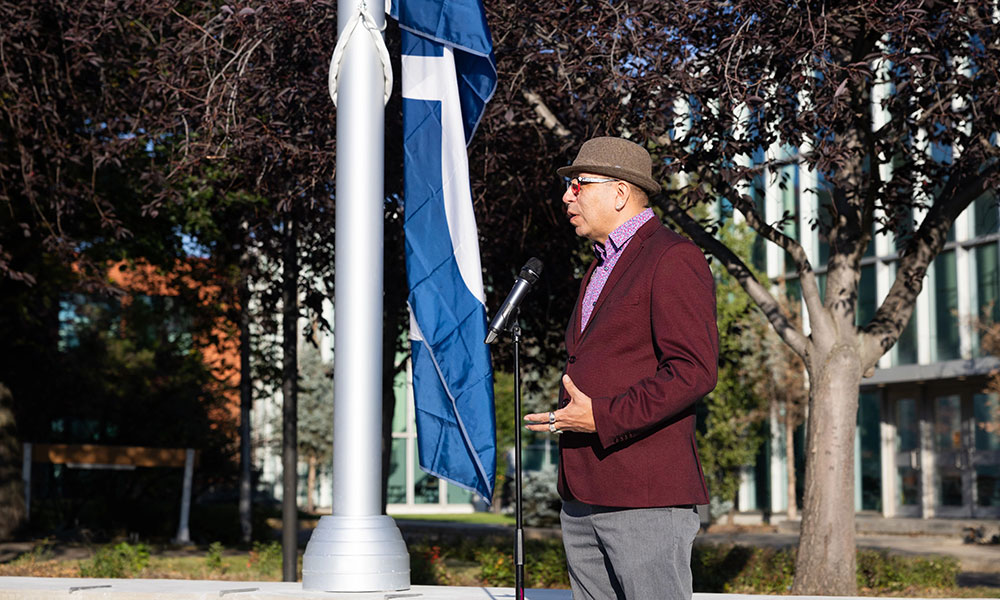“It’s a different way for people to absorb the information”
For Derek Thunder, including the drums and singing of a traditional honour song in a video version of NAIT’s territorial land acknowledgement made perfect sense.
“The drum is the heartbeat of Mother Earth,” says the manager of the Nîsôhkamâtotân Centre, a place at NAIT where Aboriginal and non-Aboriginal students can gather to network, study and share their post-secondary learning experiences.
The song, performed by cultural adviser Lonny Potts and his son, Muskwa, can be heard in the production alongside students and staff from a variety of cultural backgrounds reading the acknowledgement. Originally suggested by the institute’s Board of Governors, that video is now available for use by all students and staff at the start of events.
Having contributed to its creation, Thunder feels the production has added a new dimension to NAIT’s current land acknowledgement, written in 2021. It has also opened the door to conversations, he adds, about the role the acknowledgement plays in truth and reconciliation at the institute.
“If anything we do can lead to some sort of education, let's do it,” says Thunder.
Preserving connections
Sometimes, repetition can obscure or even erode meaning. Presenting NAIT’s land acknowledgment visually can help re-emphasize its significance, says Aboriginal liaison specialist Camille Louis.
“It’s a different way for people to absorb the information, which is good,” says Louis. “It needs to be fresh.” Otherwise, she adds, “you become a little desensitized.”
A risk of that desensitization is broken connections, such as to the spirit in which land acknowledgements have been delivered for hundreds of years. The practice, Louis points out, “predates Canada and the numbered treaties.”
“It needs to be fresh.” Otherwise, “you become a little desensitized.”
When visiting the territory of another Indigenous Peoples, she says, a group would recognize their hosts as the rightful stewards of that land, and ask their blessing to be there. In doing so, they established a tradition rooted in paying respect that in recent years would come to be considered as an act of reconciliation.
Another connection preserved by enhancing the land acknowledgement is the one linking the polytechnic to the intention of Connecting the Four Directions, says Louis. Released in 2019, the document serves as a guide for the institute “to bring Aboriginal ways of living and knowing to NAIT’s promises” to students, industry, staff and Alberta.
“What is NAIT committing to and how are we doing it?” Louis asks. “What do we need to do?
“Those are the conversations that we need to keep having.”
Truth, reconciliation and representation

That “we” includes First Nations, Métis Peoples and a settler population that also comprises those newly arrived to Canada. “If you’re here, you should be represented in some way,” says Louis.
For Melanie Rogers, vice-president external relations, capturing that diversity was essential to creating a land acknowledgement that was true to NAIT, attended daily by students and staff from around the world.
“The variety of voices is symbolic,” says Rogers. “It represents how important it is that we all come together to acknowledge treaty land, and to remember, to learn, and to move forward, united in our efforts toward truth and reconciliation."
While Thunder sees the video as “wonderful,” he adds that any kind of land acknowledgment is, ultimately, a small part of a long journey. It can also serve as an entry point into the broader and ongoing conversation about the history shared by Indigenous and non-Indigenous people in Canada.
“[It] is only the beginning of what we can do to support truth and reconciliation,” he says.
That may mean having a discussion about whether choosing to play a video – even one that strives to pay homage to the land as much as acknowledge it – is the right approach. In some cases, there may be a more appropriate and meaningful choice.
For example, “There’s an opportunity for Aboriginal people to do land acknowledgements as well,” says Thunder.
Ultimately, whatever way an acknowledgement is delivered, the key is to ensure that the practice serves a similar purpose today as it has for centuries.
“In the bigger picture, what we’re trying to achieve is relationship building,” says Louis.
And “once you build those relationships,” says Thunder, “you build community.”